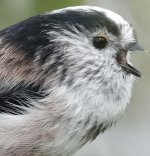Engineeringtech
Member

I have poor eyesight and only a couple windows which can be used to observe a bird feeder. And as selfish as it may seem, I don't want to feed my bird friends unless I can enjoy seeing them. Three days ago I suspended a tube feeder with small feeding ports from a hook at the ceiling of the covered front porch. While only a few feet from the door, it is high enough that I think birds will feel safe. And the front door is only rarely used. I filled the feeder with Nyjer seed. The seed was stored inside and is dry. I hoped for some Chickadees, but have yet to see any birds of any species at it... What do I do to get the birds to notice the tube feeder?
A couple more questions please... A few months ago, I hung a hopper feeder off a shepherd's hook mounted to my rear deck. There are suet cages on both ends of the hopper feeder. This contraption is within sight of the kitchen window and about 8 feet away. An inverted dome over the feeder keeps most of the seed dry. But some snow and water does occasionally get into the two trays. Although I saw a fair number of titmice, chickadees and cardinals standing on the perches and eating the seed, I haven't seen any on the perches in two weeks. I've seen a couple woodpeckers and a blue jay attack the suet, but never the seed. They are big enough that they have trouble clutching the cages and getting at the suet. How often should I take the feeder down and clean out the snow and wet seed? I know I can't keep the trays perfectly dry. I don't want the birds to get sick, but I am on a limited budget. I can't afford to change the seed every day. And how do I make the suet feeders more friendly to the jays and woodpeckers?
Thank you for your time and suggestions.
A couple more questions please... A few months ago, I hung a hopper feeder off a shepherd's hook mounted to my rear deck. There are suet cages on both ends of the hopper feeder. This contraption is within sight of the kitchen window and about 8 feet away. An inverted dome over the feeder keeps most of the seed dry. But some snow and water does occasionally get into the two trays. Although I saw a fair number of titmice, chickadees and cardinals standing on the perches and eating the seed, I haven't seen any on the perches in two weeks. I've seen a couple woodpeckers and a blue jay attack the suet, but never the seed. They are big enough that they have trouble clutching the cages and getting at the suet. How often should I take the feeder down and clean out the snow and wet seed? I know I can't keep the trays perfectly dry. I don't want the birds to get sick, but I am on a limited budget. I can't afford to change the seed every day. And how do I make the suet feeders more friendly to the jays and woodpeckers?
Thank you for your time and suggestions.





